Shaibal S. Mitra, ChairDoug Wilson, SecretaryRobert Emerson, Rachel Farrell, Paul L’Etoile, Peter Paton, and Scott Tsagarakis
D_ennis_17Apr2017_DSC_4761.jpg?ver=Qx2kHNPrQ_e9-PARDkb-Lw%3d%3d)
Snowy Plover. April 17, 2017. Goosewing Beach, Little Compton. Photograph by Geoff Dennis.
This report describes the Rhode Island Avian Records Committee’s (RIARC) evaluation of 94 records, primarily from 2016–2018, but with nine from earlier years (1998–2015). These records are summarized below within a comprehensive list of all the species and distinctive subspecies on the Rhode Island Review List, as well as several species reported in Rhode Island for the first time. Following the name of each species or subspecies on the Review List, four numbers are presented in parentheses (a, b, c, d), defined as follows:
| a |
the number of records cited by Howe and Sturtevant (1899). |
| b |
the number of records accepted from 1900–2002. This number is derived principally from the Checklist of Rhode Island Birds (Rhode Island Ornithological Club 2002), which represents a synthesis of information from Ferren (in litt.), Conway (1992), and records accepted by a pre-RIARC committee of reviewers for Field Notes of Rhode Island Birds through 2002 (Raithel 2001, 2002). A “++” represents relatively frequent historical occurrence of the species, which could be replaced with a number pending ongoing research. |
| c |
the number of accepted records from 2003–2015, including those published in RIARC’s two previous reports (Mitra et al. 2010, 2021), plus additional records from this period published here. |
| d |
the number of accepted records from 2016–2018 published in the present report. Note: the sum of a, b, c, and d represents the total number of verified records in Rhode Island through December 2018. |
To accommodate the full Review List, as well as three years’ worth of records, discussion of individual records has been kept to a minimum in this report. The Committee intends to publish its fourth report in 2023 to cover records from 2019–2022, then annual reports thereafter, with fuller discussions of each year’s individual records.
The current report features numerous highlights, including the first Rhode Island records of Graylag Goose, Snowy Plover, and Black-whiskered Vireo; second state records for Pink-footed Goose, Trumpeter Swan, Little Egret, and Townsend’s Warbler; and third state records for Mountain Bluebird and Varied Thrush. Rates of occurrence continue to increase for some species, such as Ross’s Goose, or to remain at higher than historical levels for others, such as Sandhill Crane. In contrast, other species have occurred less frequently in recent years than in the past, notably Eared Grebe, King Rail, Little Gull, and Gull-billed Tern.
For each record below, we list the RIARC Committee report number; the vote of the Committee (accept–not accept, or when three numbers then accept–not accept–accept identification but natural status uncertain); the number of individuals; the location of record; the date(s) of occurrence; and the observer(s), with the following codes: I = initial finder, R = provided a written report, and P = provided photo(s).
Fulvous Whistling-Duck (Dendrocygna bicolor) (0, 4, 0, 0)
Ross’s Goose (Anser rossii) (0, 1, 2, 6)
2016–07 (7–0): One; Cottrell’s Farm, West Kingston; November 25, 2016; Kathy Patric (I), Scott Tsagarakis (I, R).
2016–09 (7–0): One; Easton Pond, Middletown; December 1, 2016; Elizabeth Niemiec (I, R, P).
2018–01 (7–0): One; Dugway Bridge Road, West Kingston; January 2–3, 2018; Kevin Rogers (R, P), Alan Straus (R, P).
2018–02 A, B, C (7–0): (A) Two; Little Compton; January 3, 2018; Evan Lipton (I, R), Jonathan Eckerson (I, P); (B) Two; West Main Road, Little Compton; January 13, 2018; Michael Kiernan (R, P); (C) Two; Round Pond, Little Compton, January 21, 2018; Michael McBrien (R, P).
2018–04 (7–0): Four; Waite’s Corner Road, West Kingston; January 16, 2018; Sue Talbot and Dan Finizia.
2018–07 (7–0): One; Card’s Pond Road, South Kingstown; January 19, 2018; Wayne Munns (I, R), Barbara Sherman (R, P), Kevin Rogers (R, P).
2018–08 (7–0): One; Marsh Meadows, Jamestown; January 22–25, 2018; Matt Schenck (I, R, P), Jessica Kiamco (R, P).
2018–09 (7–0): Three; Sakonnet Point Road, Little Compton; February 14, 2018; Evan Lipton (R, P).
Ross’s Goose continues to increase in Rhode Island, as in neighboring states. For 2018, records 1 and 4 and records 2 and 9 are united in the summary statistics.
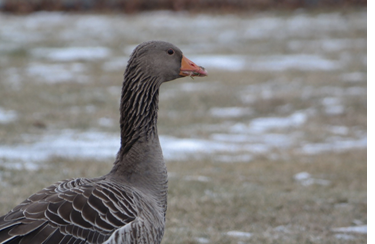
Graylag Goose. February 5, 2017. Slater Park, Pawtucket. Photograph by David Blanchette.
Graylag Goose (Anser anser) (0, 0, 0, 1)
2016–11 (5–0–2): One; Watchemoket Cove, East Providence and Slater Park, Pawtucket; December 20, 2016, to January 25, 2017; Gabe Cohen-Glinick (I, R, P), multiple observers (P).
Given the ubiquity of domesticated Graylag Geese, the documentation for this well-studied bird was given intense scrutiny. Recognition of this species as a natural vagrant to eastern North America dates to spring 2005, when one was recorded on an oil rig 200 kilometers southeast of St. John’s, Newfoundland (Maybank 2005). Since then, about a dozen plausibly wild birds have been observed in northeastern North America. These records follow major increases in the Icelandic breeding population from 1960 to 1990, and, more recently, breeding in Greenland (A. Fox, personal communication). Two Committee members were concerned that the present bird’s context, far from the outer coast and in association with resident Canada Geese, contrasted with that expected for naturally occurring Palearctic Geese in Rhode Island, but other members cited Watchemoket Cove as a traditional site for rare waterfowl and other vagrant waterbirds. Under the bylaws of the RIARC, this record was accepted with five votes to accept, zero to not accept, and two accepting the identification but expressing uncertainty over natural status.
Pink-footed Goose (Anser brachyrhynchus) (0, 0, 1, 4)
2016–05 (7–0): One; Slocum, North Kingstown; November 14–18, 2016; Steve Brenner (I, R, P), Carlos Pedro (P), Don Heitzmann (P).2017–16 (7–0): One; Westerly; December 20, 2017, to January 15, 2018; Chris Elphick (I, R, P), Anthony Vicciarelli (P), Andy Boyce (P).
2018–03 (6–1): One; Little Compton; January 3, 2018; Evan Lipton (I, R), Jonathan Eckerson (I, R, P).
2018–10 (7–0): One; Warren; February 21, 2018; Liam Waters (I, R, P).
Rhode Island’s first state record, two birds in Newport in early 2007, was among the earliest documented records of this species in the Northeast. Since then, regional occurrence has increased, including these additional records in Rhode Island.
Barnacle Goose (Branta leucopsis) (0, 5, 2, 0)
Cackling Goose (Branta hutchinsii) (0, 0, 4, 1)
2017–01 (7–0): One; Green End Avenue, Middletown; January 5, 2017; Bob Weaver (I, R, P).
Bob Weaver’s capable documentation of this nominate Cackling Goose adds to our understanding of the occurrence of this scarce and difficult to identify species, especially given the potential for other subspecies as very rare vagrants.
Trumpeter Swan (Cygnus buccinator) (0, 0, 1, 1)
2018–12 (7–0): One; Clay Head Swamp, Block Island; April 8–13, 2018; Heather Hatfield (I), Kim Gaffett (P), Nigel Grindley (P), Heather Spontak (P).
As breeding populations of Trumpeter Swans continue to expand in western New York State and the St. Lawrence and Lake Champlain valleys, additional Rhode Island records are to be expected. Although Tundra Swans occur regularly in the state, their numbers are so small, and the potential for confusion with Trumpeter Swan is so great, that all individuals of both species deserve careful documentation and review.
Tundra Swan (Cygnus columbianus) (1, ++, 0, 0)
“Eurasian” Green-winged Teal (Anas crecca crecca) (0, ++, 5, 0); first 1946.
Tufted Duck (Aythya fuligula) (0, 10, 7, 4)
2017–02 (7–0): One; Seekonk River, Providence; February 1–14, 2017; Dan Finizia (I, R, P), Sue Talbot (I), Scott Hobson (P).
2018–05 (7–0): Two; Ninigret NWR, Charlestown; January 16–17, 2018; Dan Finizia and Sue Talbot (I, R, P).
2018–06 (7–0): One; Trustom Pond NWR, South Kingstown; January 21 to February 12, 2018; Jeff Linkinhoker (R, P), Bill Thompson (R, P).
2018–11 (7–0): One; St. Mary’s Pond, Portsmouth; March 2–4, 2018; Jan St. Jean (I), Tim Metcalf (R, P), Richard Garrigus (R, P).
2018–41 (7–0): One; Trustom Pond NWR, South Kingstown; November 24 to December 8, 2018; Michael McBrien (P).
This Eurasian species occurs regularly in Rhode Island, possibly due to long-lived individuals returning. The presence of two birds at Ninigret Pond in January 2018 is recorded above as a single occurrence, although these two individuals could have arrived independently. The drake at nearby Trustom Pond just days later was probably one of these birds.
Smew (Mergellus albellus) (0, 2, 0, 0)
Eared Grebe (Podiceps nigricollis) (0, 28, 2, 2)
2004–06 (7–0): One; Sachem Pond, Block Island; November 7, 2004; Mary Jo Murray (I), Bob Emerson (R), Shai Mitra (R, P).
2018–29 (7–0): One; Mohegan Bluffs, Block Island; December 20, 2018; Michael McBrien (I, R, P).
2018–31 (7–0): One; Weekapaug Breachway, Westerly; December 23–30, 2018; Shai Mitra (I, R, P).
When formal review of rare bird reports in Rhode Island began in the early 2000s, this species was perceived as occurring regularly and its inclusion on the review list was debated. The subsequent pattern of just four documented records from 2003–2018 illustrates the wisdom of preserving stability in the composition of review lists, as periods of increased occurrence often prove to be temporary.
Western Grebe (Aechmophorus occidentalis) (0, 8, 2, 0)
Eurasian Collared-Dove (Streptopelia decaocto) (0, 0, 1, 0)
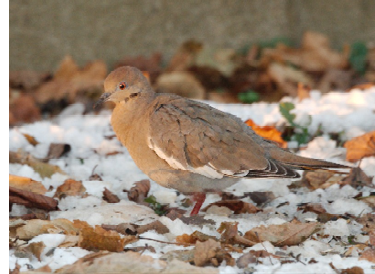
White-winged Dove. December 16, 2017. Norman Bird Sanctuary, Middletown. Photograph by Barbara Sherman.
White-winged Dove (Zenaida asiatica) (0, 1, 1, 1)
2017–18 (7–0): One; Norman Bird Sanctuary, Middletown; December 13–21, 2017; Norman Bird Sanctuary Staff (I), multiple observers (P).
Chuck-will’s-widow (Antrostomus carolinensis) (0, ++, 2, 3); first 1980.
2016–13 (7–0): One; Tillinghast Pond MA, West Greenwich; May 26 to June 26, 2016; Stephen Brenner (I), Barbara Sherman (recording).
2017–11 (7–0): One; Tillinghast Pond MA, West Greenwich; April 29 to June 25, 2017; Carlos Pedro (I), Matt Schenck (Rec), Josh Seibel (recording).
2018–39 (7–0): One; Tillinghast Pond MA, West Greenwich; May 1 to July 5, 2018; Matt Schenck (recording), Bill Ostiguy (recording).
These records of a single territorial bird at the same site over three breeding seasons probably involve the same returning individual. Broader nocturnal surveys are needed to identify additional potential breeding sites in Rhode Island’s extensive and varied pine-oak forests.
Rufous Hummingbird (Selasphorus rufus) (0, 1, 5, 0)
Rufous/Allen’s Hummingbird (Selasphorus rufus/sasin) (0, 4, 11, 4)
1996–01 (7–0): One; Little Compton yard; November 8–11, 1996; Geoff Dennis (I, R, P).
1998–01 (7–0): One; Little Compton yard; November 26, 1998; Geoff Dennis (I, R, P).
2001–03 (7–0): One; Newport; December 10, 2001, to January 23, 2002; Rick Enser (P).
2002–05 (7–0): One; Little Compton; October 23–28, 2002; Geoff Dennis (I, R, P).
2016–10 (7–0): One; Portsmouth; November 11 to December 16, 2016; Geoff Dennis (R, P).
2017–07 (7–0): One; North Kingstown; November 5 to December 1, 2017; Geoff Dennis (R, P).
2017–08 (7–0): One; Wakefield (same yard as 2005 and 2009); November 11 to December 1, 2017; Geoff Dennis (R, P).
2017–09 (7–0): One; Boon Lake, Exeter; November 18 to December 20, 2017; Dylan Pedro (P).
The Committee reviewed two records of hummingbirds reported as Rufous Hummingbird and six more reported as Rufous/Allen’s Hummingbird. On the basis of the available documentation, the Committee concluded that all records represented this species pair, but that none could be confidently identified to species at present. A thorough assessment of all such records is planned, using uniform criteria.
Calliope Hummingbird (Selasphorus calliope) (0, 0, 1, 0)
King Rail (Rallus elegans) (1, ++, 0, 1)
2016–02 (6–1): One; Great Swamp, South Kingstown; April 21–25, 2016; Stephen Brenner (P), James Restivo (R), Matt Schenck (R).
Yellow Rail (Coturnicops noveboracensis) (4, 14, 2, 0)
Black Rail (Laterallus jamaicensis) (0, 3, 1, 0)
Corn Crake (Crex crex) (1, 0, 0, 0)
Purple Gallinule (Porphyrio martinicus) (7, 9, 0, 3)
2017–03 (7–0): One; Block Island; February 27, 2017; Kim Gaffett (R).
2017–13 (7–0): One; Cooneymus Road, Block Island; November 7, 2017; Kim Gaffett (R).
2018–15 (7–0): One; Narragansett; May 12, 2018; fide Linda Ferraresso (R, P).
Sandhill Crane (Antigone canadensis) (1, 14, 9, 4)
2016–14 (7–0): Two; Great Swamp MA, South Kingstown; April 28, 2016; Louis Mendes (I, R, P).
2016–15 (7–0): One; Trustom Pond NWR, South Kingstown; December 21, 2016; Josh Cummings (R, P, eBird).
2018–19 (7–0): One; Great Swamp MA, South Kingstown; June 7–8, 2018; Carlos Pedro (I, R, P).
2018–37 (7–0): Three; Great Swamp MA, South Kingstown; November 22, 2018; Bill Thompson (I, R, P).
The abrupt increase in records from about 2009 through 2015 appears to have leveled off at a rate of one or two records per year. The repeated occurrence at Great Swamp, including multiple individuals, suggests that future breeding is possible.
Black-necked Stilt (Himantopus mexicanus) (0, 8, 2, 0)
Northern Lapwing (Vanellus vanellus) (0, 2, 1, 0)
Lesser Sand-Plover (Charadrius mongolus) (0, 1, 0, 0)
Common Ringed Plover (Charadrius hiaticula) (0, 1, 0, 0)
Snowy Plover (Charadrius nivosus) (0, 0, 0, 1)
2017–14 (7–0): One; Goosewing Beach, Little Compton; April 17, 2017; Geoff Dennis (I, R, P).
This stunning Snowy Plover in breeding plumage is the first state record for Rhode Island and one of very few records in the Northeast. Discovered by Geoff Dennis, who saw it fly off, this bird was never seen again, despite much searching the next day. Records from nearby states include prior records in June from Massachusetts and Maine, a prior record in October from Connecticut, and a subsequent record in September from upstate New York.
Wilson’s Plover (Charadrius wilsonia) (0, 10, 0, 1)
2018–25 (7–0): Two; Goosewing Beach, Little Compton; May 4–7, 2018; Carolyn Zaino (I), Geoff Dennis (R, P).
A very rare vagrant to the coastal Northeast, Wilson’s Plovers have occurred almost a dozen times along Rhode Island’s shoreline. The presence of two together is especially notable; this record is treated in our statistical summary as one occurrence, although it could be argued that their arrivals were possibly independent.
Eskimo Curlew (Numenius borealis) (++, ++, 0, 0); last 1913.
Long-billed Curlew (Numenius americanus) (++, 3, 0, 0)
Ruff (Calidris pugnax) (0, ++, 5, 2); first 1900.
2016–01 (7–0): One female; Weekapaug, Westerly; April 27 to May 2, 2016; Rey Larsen (I, R, P).
2017–21 (7–0): One male; Napatree Point, Westerly; July 23, 2017; Josh Seibel (I, R, P).
Curlew Sandpiper (Calidris ferruginea) (0, 8, 2, 1)
2018–18 (7–0): One; Napatree Point, Westerly; June 1–3, 2018; Carlos Pedro (I, R, P).
Little Stint (Calidris minuta) (0, 0, 1, 0)
Long-billed Dowitcher (Limnodromus scolopaceus) (1, ++, 5, 1)
2012–32 (7–0): One; Succotash Marsh, South Kingstown; August 11–12, 2012; Shai Mitra (I, R, P).
2016–08 (7–0): One; Quicksand Pond, Little Compton; November 24–26, 2016; Geoff Dennis (I), Doug Wilson (R, P).
Spotted Redshank (Tringa erythropus) (0, 1, 0, 0)
Wood Sandpiper (Tringa glareola) (0, 0, 1, 0)
Great Skua (Stercorarius skua) (0, 3, 0, 0)
South Polar Skua (Stercorarius maccormicki) (0, ++, 4, 1); first 1967.
2018–38 (7–0): One; south of Block Island; May 24, 2018; John Loch (I, R, P), Nick Metheney (I).
This species regularly occurs far offshore from late May through early August. However, Great Skua also occurs in Rhode Island waters and can be very difficult to distinguish from South Polar. Although Great Skua appears to be rarer than South Polar in Rhode Island and more likely in winter, its status is not understood well enough to rely on date as an indicator of identity, especially outside of the core period of occurrence of South Polar Skua in late spring. Furthermore, other skua taxa from the Southern Hemisphere might possibly occur. A bird photographed on August 10, 2017, southeast of Block Island near the East Grounds, was unquestionably a large skua (2017–17; Stephen Brenner (I, R, P)). In the single photo, the bird appears exceptionally bulky, short-tailed, and warm-toned, suggestive of Great Skua, and the record was accepted by the Committee as an unidentified large skua (Catharacta), a category for which we intend to derive summary statistics. A single observer sight report from land (2017–06) at Point Judith, Narragansett, on September 19, 2017, was not deemed sufficient to verify identification.
Long-tailed Jaeger (Stercorarius longicaudus) (0, ++, 2, 0); first 1952.
Thick-billed Murre (Uria lomvia) (4, ++, 6, 2)
2017–19 (7–0): One; Sakonnet Point, Little Compton; February 21, 2017; Evan Lipton (I, R, P).
2018–26 (7–0): One; Beavertail State Park, Jamestown; December 8, 2018; Zachary Millen (I, R, P), Brian Quindlen (I, R, P).
Long-billed Murrelet (Brachyramphus perdix) (0, 1, 0, 0)
Atlantic Puffin (Fratercula arctica) (0, 10, 5, 0)
Ivory Gull (Pagophila eburnea) (0, 1, 2, 0)
Sabine’s Gull (Xema sabini) (0, 12, 2, 0)
Little Gull (Hydrocoloeus minutus) (0, ++, 4, 1); first 1946.
2016–16 (7–0): One; Sachuest Point NWR salt marsh, Middletown; May 24, 2016; Matt Schenck (I, R, P).
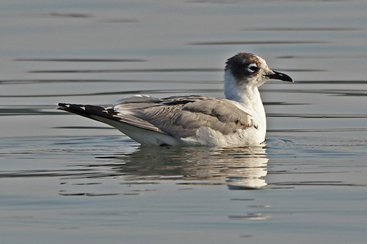
Franklin’s Gull. July 16, 2018. Sachuest Point NWR, Middletown. Photograph by Matt Schenck.
Franklin’s Gull (Leucophaeus pipixcan) (0, 5, 4, 1)
2018–20 (7–0): One; Sachuest Point NWR, Middletown; July 16, 2018; Matt Schenck (I, R, P), Rey Larsen (P).
Black-tailed Gull (Larus crassirostris) (0, 1, 0, 0)
“Thayer’s” Iceland Gull (Larus glaucoides thayeri) (0, 7, 1, 0)
2014–16 (7–0): One; Cox’s Ledge; December 20, 2014; Tom Auer (I, R), Dan Finizia (P), Keith Mueller (P), Ford Parker (P), Paul L’Etoile (P).
This report of a notoriously challenging taxon went through multiple rounds of review over several years, during which Thayer’s Gull was lumped with Iceland Gull! Thayer’s Gull has a documented history of occurrence in Rhode Island, and the Committee agreed to retain this subspecies on the Review List. RIARC agreed that the photographs classified this individual within the expected range of variation for thayeri.
Bridled Tern (Onychoprion anaethetus) (0, 5, 3, 0)
Sooty Tern (Onychoprion fuscatus) (2, 10, 1, 0)

Gull-billed Tern. May 19, 2017. Charlestown Breachway, Charlestown. Photograph by Paul L’Etoile.
Gull-billed Tern (Gelochelidon nilotica) (0, 29, 0, 1)
2017–05 (7–0): One; Charlestown Breachway, Charlestown; May 19, 2017; Paul L’Etoile (I, R, P)
Compared to the late 20th century, the occurrence in Rhode Island of Gull-billed Terns has diminished dramatically over the past two decades.
Arctic Tern (Sterna paradisaea) (0, 13, 0, 1)
2018–40 (6–1): One; Point Judith, Narragansett; August 20, 2018; Shai Mitra (I, R).
Given the paucity of documented records of this species in Rhode Island, photographic documentation is much desired, but not possible for this record. However, a detailed description of plumage and structure was provided by the observer, who is intimately familiar with all plumages of this species and has found and photographed many dozens of them on Long Island, New York. The date is unusual for coastal southern New England away from breeding sites, as most records of Arctic occur from late May through mid-July (Mitra 2009).
Sandwich Tern (Thalasseus sandvicensis) (0, 23, 7, 0)
2007–29 (7–0): One; Ninigret Mudflats, Charlestown; August 15, 2007; Carlos Pedro (P).
Brown Noddy (Anous stolidus) (0, 3, 0, 0)
White-tailed Tropicbird (Phaethon lepturus) (0, 2, 0, 0)
Red-billed Tropicbird (Phaethon aethereus) (0, 2, 1, 0)
Pacific Loon (Gavia pacifica) (0, ++, 12, 2); first 1941.
2017–12 (7–0): One; Central Beach, Charlestown; December 17, 2017; Sean Camillieri (I, R, P), Scott Tsagarakis (I), Carlos Pedro (P).
2018–33 (7–0): One; Block Island; December 20, 2018; Michael McBrien (I, R, P).
Yellow-nosed Albatross (Thalassarche chlororhynchos) (0, 3, 0, 0)
White-faced Storm-Petrel (Pelagodroma marina) (0, 4, 1, 1)
2018–28 (7–0): One; Block Canyon; September 3, 2018; Wayne Munns (I, R), Phil Rusch (I), Scott Tsagarakis (I), Carlos Pedro (I).
Leach’s Storm-Petrel (Hydrobates leucorhous) (3, ++, 2, 0)
Band-rumped Storm-Petrel (Hydrobates castro) (0, 0, 2, 0)
2018–27 (0–7): Three; Block Canyon; September 3, 2018.
The Committee debated these reports at length, with considerable support for the identification, based on the experience of the observers and multiple details in the written descriptions. However, the only photos were of Wilson’s Storm-Petrels. Possibly the wrong individual(s) was photographed under the challenging and brief opportunity at sea, but overall, the documentation was not deemed sufficient to substantiate a record of a species that remains little known in Rhode Island waters.
Black-capped Petrel (Pterodroma hasitata) (0, 2, 2, 0)
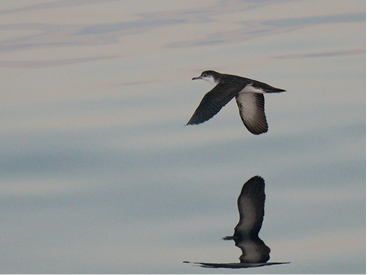
Audubon’s Shearwater. September 3, 2018. Block Canyon, pelagic. Photograph by Paul L’Etoile.
Audubon’s Shearwater (Puffinus lherminieri) (0, ++, 4, 1); first 1938.
2018–32 (7–0): Nine; Block Canyon; September 3, 2018; Wayne Munns (R), Carlos Pedro (P), Bill Thompson (P).
Records of Audubon’s Shearwaters in Rhode Island waters remain few. This species often occurs in groups, and for this reason, and because not all the birds were photographed, this record was counted as a single occurrence in our summary statistics.
Wood Stork (Mycteria americana) (1, 0, 0, 0)
Magnificent Frigatebird (Fregata magnificens) (0, 10, 2, 1)
2018–30 (7–0): One; Point Judith, Narragansett; December 22, 2018; Phil Rusch (I, R), Glenn Williams (I, R), James Restivo (P).
Brown Booby (Sula leucogaster) (0, 3, 1, 0)
Anhinga (Anhinga anhinga) (0, 3, 0, 0)
American White Pelican (Pelecanus erythrorhynchos) (0, 8, 8, 0)
Brown Pelican (Pelecanus occidentalis) (0, 14, 7, 2)
2018–17 (6–0): One; A: Newport B: Warren River, Warren; May 26, 2018; A: Charles Avenengo and Francisca deLima (I, R, P); B: unknown fisherman (I, R, P), fide Rachel Farrell.
2018–21 (7–0): One; Sakonnet Point, Little Compton; July 16, 2018; Evan Lipton (I, R, P).
Little Egret (Egretta garzetta) (0, 1, 0, 1)
2018–22 (7–0): One; Napatree Point and Weekapaug, Westerly; August 4 to September 5, 2018; Barbara Gearhart (I, R, P), multiple observers (P).
This individual bird was often difficult to find, but was seen and photographed by many during its month-long stay.
Reddish Egret (Egretta rufescens) (0, 0, 1, 0)
White Ibis (Eudocimus albus) (0, 6, 4, 0)
White-faced Ibis (Plegadis chihi) (0, 2, 6, 2)
2017–04 (6–1): Two; Saint Mary’s Pond, Portsmouth; April 25, 2017; Matt Schenck (I, R, P).
2018–36 (6–1): One; Sapowet WMA, Tiverton; June 24, 2018; Evan Lipton (I, R, P).
Swallow-tailed Kite (Elanoides forficatus) (0, 6, 4, 0)
Golden Eagle (Aquila chrysaetos) (5, ++, 5, 0)
2015–27 (7–0): One; Tiogue Lake, Coventry; November 16, 2015; Matt Schenck (I, R, P), Susan Schenck (I, R) eBird.
Mississippi Kite (Ictinia mississippiensis) (0, 6, 6, 2)
2015–26 (6–1): One; West Kingston; May 31, 2015; Tom Auer (I, R, P).
2016–03 (7–0): One; Block Island; July 7, 2016; Catherine Joyce and Nigel Grindley (I, R, P).
2016–17 (7–0): One; Coventry; June 1, 2016; Matt Schenck (I, R, P), Susan Schenck (I, R, P).
Zone-tailed Hawk (Buteo albonotatus) (0, 0, 1, 0)
Swainson’s Hawk (Buteo swainsoni) (0, 4, 0, 0)
Northern Hawk Owl (Surnia ulula) (1, 1, 0, 0)
Burrowing Owl (Athene cunicularia) (0, 1, 0, 0)
Great Gray Owl (Strix nebulosa) (2, 3, 0, 0)
Boreal Owl (Aegolius funereus) (5, 0, 0, 0)
Lewis’s Woodpecker (Melanerpes lewis) (0, 1, 0, 0)
American Three-toed Woodpecker (Picoides dorsalis) (0, 3, 0, 0)
Black-backed Woodpecker (Picoides arcticus) (0, 6, 0, 0)
Gyrfalcon (Falco rusticolus) (5, ++, 0, 0); last 1995
Ash-throated Flycatcher (Myiarchus cinerascens) (0, 6, 2, 3)
2016–06 (7–0): One; Carpenter’s Beach, South Kingstown; November 12–13, 2016; Scott Tsagarakis (I).
2016–20 (6–1): One; Blackstone Bike Path, Cumberland; December 3, 2016; Joseph McGlinchey (I, R, P).
2017–20 (7–0): One; Little Compton; November 25 to December 10, 2017; James Osborne (I), Evan Lipton (R, P).
Western Kingbird (Tyrannus verticalis) (0, ++, 7, 0); first 1913.
2015–25 (6–1): One; Sachuest Point NWR, Middletown; September 12, 2015; Dan Berard and Danielle Crudden (I), Matt Schenck (P).
Although this is a rare but regular migrant in the coastal Northeast, the rate of occurrence in Rhode Island has been lower in recent decades than during the latter half of the 20th century. This record was supported by one photograph and by virtue of the experience of the observers, but several Committee members expressed a desire for a more detailed write-up.
Scissor-tailed Flycatcher (Tyrannus forficatus) (0, 5, 2, 1)
2014–08 (6-1): One; Carter Preserve, Charlestown; June 3, 2014; Steve DelPozzo, Mary Jo Murray, Jeannie Dougherty, Nancy Clayton, and Jeff Hall (I, R), Dan Finizia (R, P), Sue Talbot (R, P).
2018–14 (7–0): One; Trustom Pond NWR, South Kingstown; May 2–3, 2018; Susan Carlson (I, R), Robert Weaver (P), Alan Strauss (P).
The Charlestown report involved an immature bird (probably second calendar year but resembling a juvenile in terms of its very limited and yellow-toned ventral coloring) with broken and abraded rectrices. Several helpful photos were provided but as is often the case, these images did not show every important feature, e.g., underwing color, and were difficult to interpret for some features, e.g., mantle tone and wing covert pattern. Some Committee members felt that the bird was suggestive of a hybrid with Western Kingbird, and the record went through multiple rounds of review before being accepted.
Fork-tailed Flycatcher (Tyrannus savana) (0, 3, 1, 0)
Hammond’s Flycatcher (Empidonax hammondii) (0, 1, 0, 0)
Say’s Phoebe (Sayornis saya) (0, 4, 1, 0)
Vermilion Flycatcher (Pyrocephalus rubinus) (0, 1, 0, 0)
Loggerhead Shrike (Lanius ludovicianus) (2, ++, 0, 0)

Black-whiskered Vireo. May 21, 2018. Sakonnet Point, Little Compton. Photograph by Evan Lipton.
Black-whiskered Vireo (Vireo altiloquus) (0, 0, 0, 1)
2018–16 (7–0): One; Sakonnet Point, Little Compton; May 21, 2018; Evan Lipton (I, R, P).
The discovery and documentation of this astonishing first state record is to the great credit of Evan Lipton’s attentiveness and skills. It was seen only briefly, and, like the Snowy Plover described above, not re-found. As unexpected as this spring record might have seemed, it foreshadowed Massachusetts’s first, just less than a year later, on April 21, 2019, on Martha’s Vineyard.
Eurasian Jackdaw (Corvus monedula) (0, 1, 0, 0)
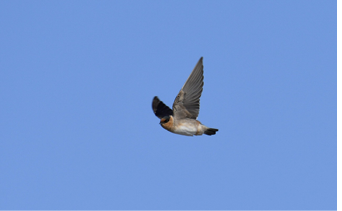
Cave Swallow. November 12, 2018. Scarborough Beach, Narragansett. Photograph by Sam Miller.
Cave Swallow (Petrochelidon fulva) (0, 2, 10, 3)
2008–17 (7–0): Two; Goosewing Beach, Little Compton; November 12, 2008; Geoff Dennis (I, R, P, eBird).
2012–31 (7–0): Two; Sakonnet Point, Little Compton; November 18, 2012; Geoff Dennis (I, R, P, eBird).
2016–18 (7–0): One; Moonstone Beach, South Kingstown; October 24, 2016; Shai Mitra (I, R).
2018–34 (7–0): One; Trustom Pond NWR, South Kingstown; November 10, 2018; Dave Mozzoni (I, R, P, eBird).
2018–35 (7–0): One; Scarborough Beach, Narragansett; November 12, 2018; Barbara Gearhart (I), Sam Miller (P).
Boreal Chickadee (Poecile hudsonicus) (1, ++, 0, 0); last 1982.
Sedge Wren (Cistothorus stellaris) (1, ++, 3, 0)
Bewick’s Wren (Thryomanes bewickii) (0, 1, 0, 0)
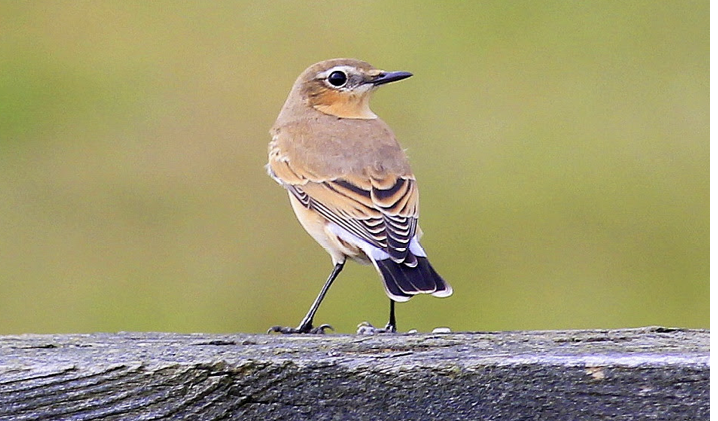
Northern Wheatear. September 20, 2016. Colt State Park, Bristol. Photograph by Pete Rawlings.
Northern Wheatear (Oenanthe oenanthe) (0, 5, 6, 1)
2016–04 (7–0): One; Colt State Park, Bristol; September 20–24, 2016; Mike McBrien (I), multiple observers (P).
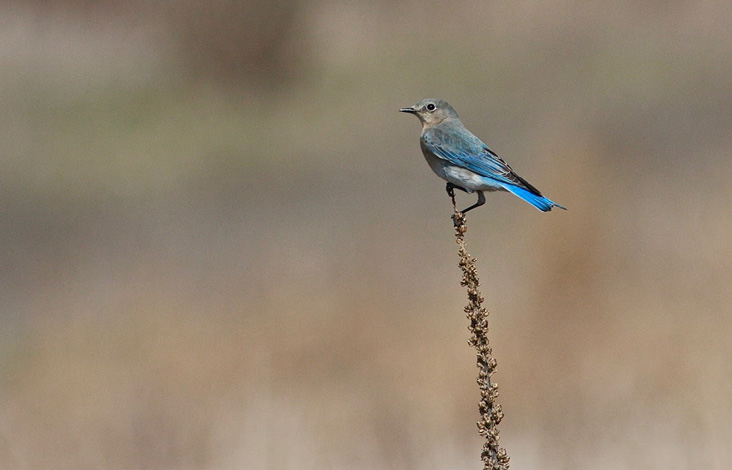
Mountain Bluebird. April 12, 2018. Big River Management Area, West Greenwich. Photograph by Carlos Pedro.
Mountain Bluebird (Sialia currucoides) (0, 1, 1, 1)
2018–13 (7–0): One; Big River MA, West Greenwich; April 10–13, 2018; Dylan Pedro (I, R, P, eBird), Carlos Pedro (P).
Townsend’s Solitaire (Myadestes townsendi) (0, 2, 1, 0)
Bicknell’s Thrush (Catharus bicknelli) (unknown, 1)
2016–19 (7–0): One; Block Island Banding Station; September 24, 2016; Stephen Brenner (R, P, eBird).
Banded.
Redwing (Turdus iliacus) (0, 1, 0, 0)
Varied Thrush (Ixoreus naevius) (0, 2, 0, 1)
2018–24 (7–0): One; Block Island—The Maze; October 31, 2018; Clara Cooper-Mullin (I, R, P. eBird).
Banded.
Bohemian Waxwing (Bombycilla garrulus) (0, 2, 2, 0)
Phainopepla (Phainopepla nitens) (0, 1, 0, 0)
Pine Grosbeak (Pinicola enucleator) (++, ++, 2, 0)
Hoary Redpoll (Acanthis hornemanni) (0, 11, 2, 0)
Smith’s Longspur (Calcarius pictus) (0, 1, 0, 0)
Harris’s Sparrow (Zonotrichia querula) (0, 2, 0, 0)
LeConte’s Sparrow (Ammospiza leconteii) (0, 1, 4, 1)
2017–15 (6–1): One; Warren; December 12, 2017; Tom Seiter (I, R), Steve Davis (R).
Given how difficult this species can be to observe in the field, the Committee commends the observers for providing detailed descriptions and a rigorous analysis. One member had some uncertainty, based on the absence of photos and the challenges of verifying identification.
Henslow’s Sparrow (Centronyx henslowii) (1, ++, 0, 0); last 1968.
Green-tailed Towhee (Pipilo chlorurus) (0, 1, 1, 0)
Yellow-headed Blackbird (Xanthocephalus xanthocephalus) (0, ++, 8, 0); first 1919.
Western Meadowlark (Sturnella neglecta) (0, 2, 0, 0)
Bullock’s Oriole (Icterus bullockii) (0, 2, 0, 0)
Brewer’s Blackbird (Euphagus cyanocephalus) (0, 5, 0, 0)
Boat-tailed Grackle (Quiscalus major) (0, 2, 4, 0)
Swainson’s Warbler (Limnothlypis swainsonii) (0, 0, 1, 0)
Black-throated Gray Warbler (Setophaga nigrescens) (0, 4, 0, 0)
Townsend’s Warbler (Setophaga townsendi) (0, 1, 0, 1)
2017–10 (7–0): One; Trustom Pond NWR, South Kingstown; November 24–28, 2017; Robert Askins (I), multiple observers (P).
Western Tanager (Piranga ludoviciana) (0, 7, 3, 1)
2016–12 (7–0): One; Ninigret Park, Charlestown; December 26–28, 2016; Geoff LeBaron (I), Doug Wilson (I, R, P), Rick Murnane (I), Robert Weaver (P).
Black-headed Grosbeak (Pheucticus melanocephalus) (0, 4, 1, 0)
Painted Bunting (Passerina ciris) (1, 8, 3, 1)
2018–23 (7–0): One; Jamestown; October 18, 2018; Chris Powell (I, R, P).
Literature Cited
- Howe, R. H. and E. Sturtevant. 1899. The Birds of Rhode Island. Privately printed. 111 pp.
- Maybank, B. 2005. Atlantic Provinces & St. Pierre et Miquelon. North American Birds 59:396–399.
- Mitra, S. S. 2009. Regular inshore occurrence of non-breeding Arctic Terns (Sterna paradisaea) during summer on Long Island, New York. The Kingbird 59:2–11.
- Mitra, S. S., D. Wilson, R. Emerson, R. Farrell, R. Ferren, C. Raithel, and S. Tsagarakis. 2010. First Report of the Rhode Island Avian Records Committee. Bird Observer 38:275–283.
- Mitra, S. S., D. Wilson, R. Emerson, R. Farrell, R. Ferren, P. L’Etoile, P. Paton, C. Raithel, and S. Tsagarakis. 2021. Second Report of the Rhode Island Avian Records Committee. Bird Observer 49:29–53.
- Raithel, C. J. 2001. 1999 Report of the Rhode Island Rare Bird Committee. Field Notes of Rhode Island Birds 382:19–21.
- Raithel, C. J. 2002. Report of the Rare Bird Committee. Field Notes of Rhode Island Birds 396:24–26.
- Rhode Island Ornithological Club. 2002. Checklist of Rhode Island Birds.
